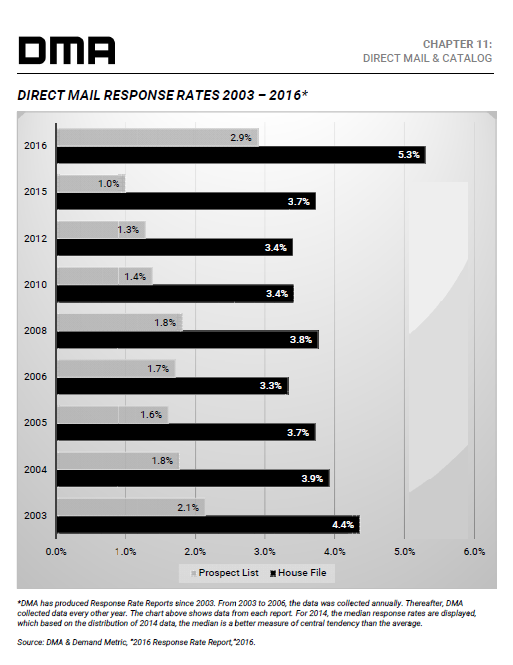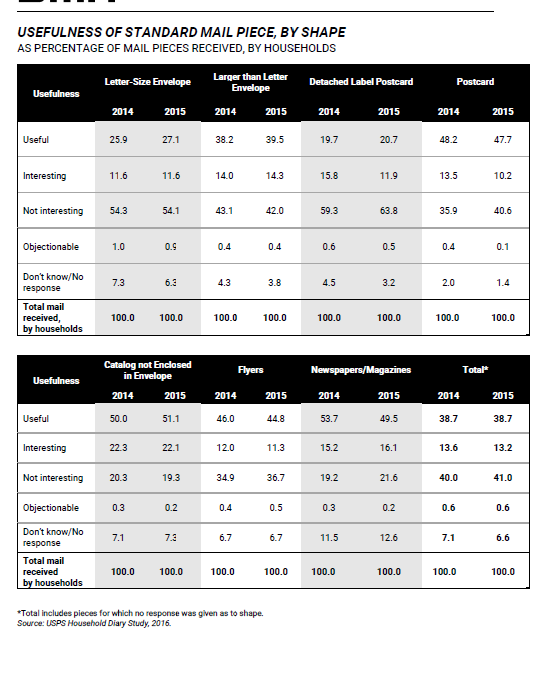Lois Brayfield, J.Schmid CEO, and Lauren Ackerman, J.Schmid Web Content Specialist, offer their take on the catalog and direct mail industry in the recently published DMA Statistical Fact Book 2017. Learn more about this valuable resource packed with recent research for all marketing tactics here.
The numbers are in, and the message is clear: print is impactful, interesting and POWERFUL.
Customer response rates increased year-over-year by an impressive 43%, but prospect response rates more than doubled – reporting an astounding 190% increase! So it’s no wonder that brands that have never mailed before are finding it a viable medium for both their retention and acquisition efforts.
In a digitally dominated world, how could this happen?
The big change is an increase in mailings paired with digital intelligence – browsing behavior and sophisticated modeling based on preferences make mailings extra timely and relevant.
Moreover, thanks to neuro-marketing and haptic research we are beginning to discover the power of direct mail as a physical and tangible medium. A recent study by SAPPI discovered that when touch is part of the marketing experience, it helps shift the brain into a deeper level of engagement while building knowledge. When we physically touch direct mail, it creates what scientists call the “endowment affect” which creates a sense of ownership. Furthermore, consumers understand and remember what they read on paper better than what they read on a screen (Proust and the Squid, Maryanne Wolf). This is created by the physicality of paper. Why? Three reasons:
- Content is more intuitively navigable.
- It facilitates better mental “mapping” of information.
- Reading on paper drains fewer of our cognitive resources, making retention easier.
Because direct mail is higher-cost than its online counterpart, it’s critical that marketers continue to look for ways to create higher impact. Again, testing neuro-marketing research in direct mail we’ve found that three things ring true:
- Be bold. Humans have an attention span of 8 seconds. Marketing that cuts through the clutter with attention-getting graphics and copy are paramount to success.
- Visuals rule. In fact, the brain processes visuals 60,0000 times faster than the time it takes the brain to decode text. Selling your story with pictures and graphics is a must.
- Keep it simple. Due to cognitive fluency, the brain craves ease and order. Direct mail that creates a simple decision path with limited copy and explanation always tests better.
So what have we learned? Powerful creative amped up and laser focused with data is the sweet spot. The early adopters have proven it, and now the rest of the marketing world is following suit. Data insights combined with the physicality of print: a match made in heaven.
Direct Mail
While overall response continues to increase, there was a slight (2%) decrease in overall mail delivered according to the USPS. This is most likely due to better targeting and larger budgets directed to online efforts. As the world migrates to time spent online and with mobile, this makes perfect sense.
Postcards benefited from our ever-compressed schedules, as people reported that they read postcards in greater numbers with a 3.9% year-over-year increase (USPS Household Diary Study.)
A Marketing Sherpa report found that the top reasons why people ignore direct mail are that there’s simply too much of it, and lack of time. With this in mind, brands are successfully testing new ways to stand out in the mail. Innovative marketers are testing sensory devices by integrating smell, touch, taste, sound and even video (embedding a wafer-thin video player) into their mailers. Termed as “embodied cognition” we’ve learned that the more senses we appeal to the stronger the message is encoded; thus, increased response rates.
In all the research, a clear pattern is emerging: customers do not want to be bogged down with detail. They are seeking convenient solutions that will enhance their life. Thus, there has been a surge in subscription-based campaigns like Blue Apron and Stitch Fix who effectively use both online and offline methods to create an incredibly easy decision path.
The improvements we’ve seen in response and read rates mean that marketers are paying attention, taking advantage of both online and offline data to create a more efficient contact strategy. Specifically, brands have discovered the power of using online browsing behavior to prompt personalized mail using variable printing. Marketers should begin testing this format as long as it stands out and quickly conveys the call-to-action.
And finally, don’t buy into the misconception that print only works for an older market. According to the research, all age groups are interested in receiving and responding to mail. In fact, for ages 18-21 response rates doubled in 2016! (USPS Household Diary Study) However, this does not mean one size fits all. Direct marketers face interesting challenges in communicating with unique age segments requiring specific content that meets their generational need, and research is paramount to understanding how to craft relevant messages.
Catalogs
Catalogs had a stellar year, standing out both for engagement and their ability to drive sales. Proving that catalogs are a formidable web driver, 30% of people polled reported that a catalog recently drove them online to shop (Quad Graphics Customer Focus), with millennials and Gen-Xers reporting in at 38%.
Which was a likely factor for the 75% of marketers that reported they plan to prospect using a catalog in the coming year, the 85% who plan to maintain or increase circulation, and 88% who plan to maintain or increase page counts (Multichannel Merchant).
On the engagement front, people found catalogs the most interesting type of standard mail – even surpassing newspapers and magazines by 31% (USPS Household Diary Study).
While there has been a 4.5% decrease in catalogs mailed (DMA), we’ve seen a 23% increase in overall response (USPS Household Diary Study). So, fewer catalogs mailed and an increase in response? Again, it’s all due to better targeting, less prospecting and a tendency towards a combination of both branding and selling within the pages of a catalog.
Ever looming is the threat of decreased margins due to competition with Amazon, which makes it imperative to create exclusive products that can only be found in your merchandise assortment.
On the positive side, mailers will soon be able to mail more for less, as the Postal Regulatory Commission has approved an increase in the break point for Standard Mail flats from 3.3 ounces to 4.0 ounces as urged by the American Catalog Mailers Association (ACMA). This change will motivate mailers to increase paper weight and add profitable content next year.
It’s clear that marketers are quickly learning where catalogs fit in the omnichannel puzzle: it’s a standout engagement tool, a brand-enhancer and a mighty push online. As we continue to bring customer intelligence in the mix, catalogs are only going to become more relevant.
Get your hands on more amazing content – purchase the entire state book at https://thedma.org/marketing-insights/dma-factbook/
Tags: catalog industry, catalog marketing, Catalog Research, Direct Mail Industry, DMA, DMA Stat Book





